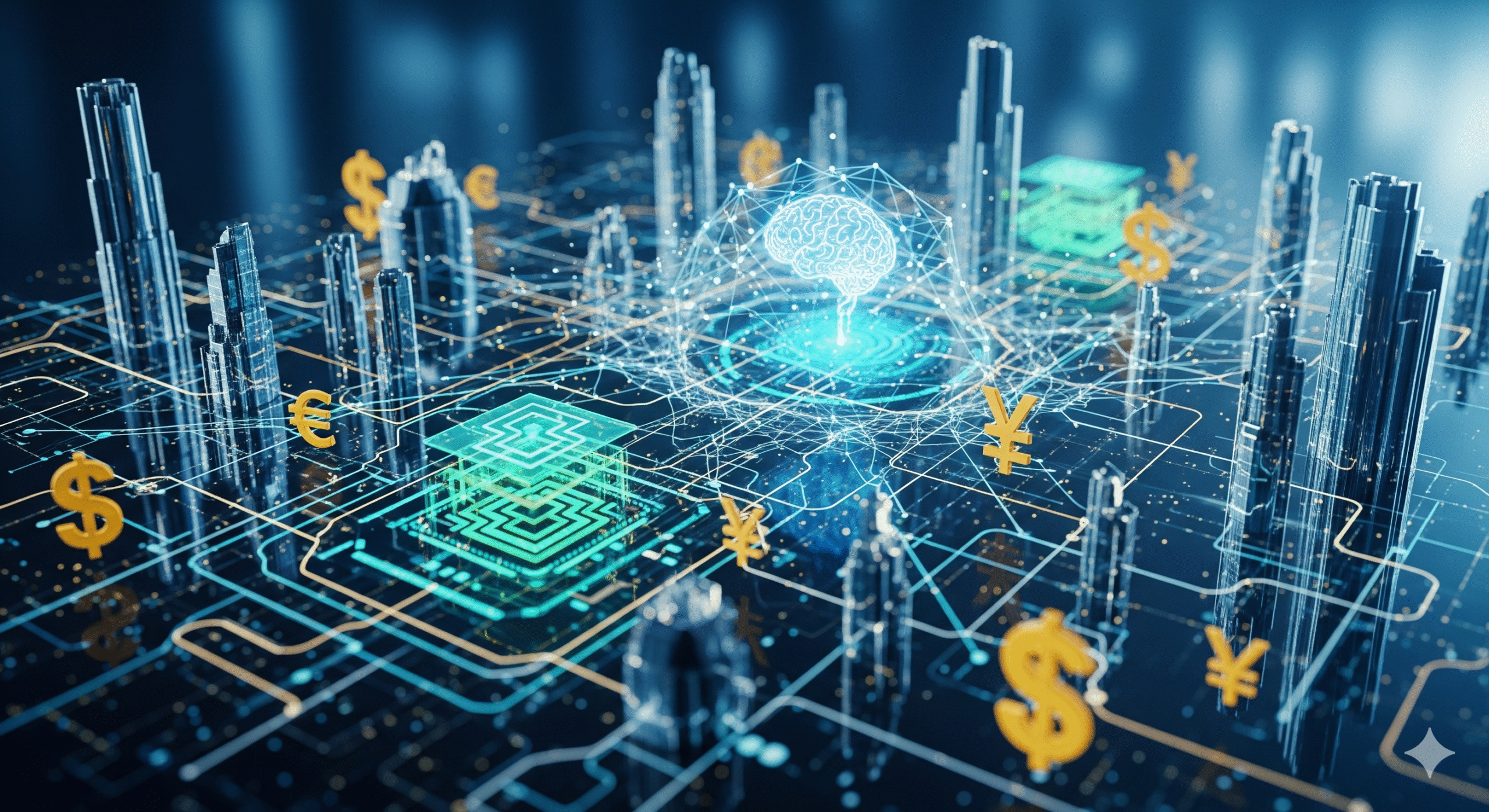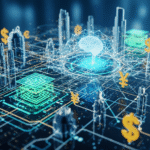Imagine a time when you had to physically go to a bank to transfer money, a store to buy anything, or an office to meet a colleague. It wasn’t that long ago, was it? We’ve all seen the internet and the smartphone revolutionize our lives. But what’s happening now is a different kind of revolution—it’s a transformation so fundamental that it’s reshaping the very DNA of commerce and finance. Understanding how technology is changing the future of business and money isn’t just for tech gurus and financiers anymore; it’s for every entrepreneur, every employee, and every consumer who wants to stay ahead of the curve.
This isn’t a slow-moving evolution; it’s a tidal wave of innovation powered by technologies like artificial intelligence, blockchain, and hyper-automation. These aren’t just buzzwords; they are the building blocks of a new economy. In this comprehensive guide, we’ll peel back the layers to reveal how these technological forces are disrupting old models, creating new opportunities, and redefining what’s possible. Whether you’re a small business owner, a corporate executive, or someone simply curious about the future, this article will equip you with the knowledge to navigate this seismic shift.
Background and Context: From E-commerce to Decentralization
The first wave of technological disruption in business and money was marked by the rise of the internet. It democratized information, made e-commerce a household term, and allowed for global communication in an instant. This era gave us giants like Amazon and eBay, which fundamentally changed how we shop. We moved from physical storefronts to digital marketplaces.
Then came the mobile revolution. Smartphones put the internet in our pockets, paving the way for apps, mobile payments, and a 24/7 connection to our digital lives. Companies like Uber and Airbnb leveraged this connectivity to create “platform economies,” completely upending the taxi and hospitality industries.
Today, we are in the midst of a third, more profound technological shift. This new era is defined by technologies that don’t just digitize old processes; they automate them, decentralize them, and give them a level of intelligence that was previously unimaginable. We’re moving from a world of simple digitalization to a world of autonomous and intelligent systems. This is the new reality, and it’s where we truly begin to see how technology is changing the future of business and money.
Detailed Comparison: The Old Way vs. The New Way
To grasp the full scale of this transformation, it’s helpful to compare the traditional business and financial landscape with the technology-driven future. The following table highlights the key differences.
| Aspect | Traditional Business & Finance | Technology-Driven Future |
| Decision-Making | Relied on manual data analysis, gut feelings, and historical trends. Slow, often reactive, and prone to human bias. | Powered by AI and Machine Learning. Data is analyzed in real-time, providing predictive insights and automated recommendations. Decisions are proactive and data-driven. |
| Customer Experience | Standardized service, brick-and-mortar stores, and call centers. Limited personalization and often required physical presence. | Hyper-personalized experiences through CRM systems, chatbots, and AI-driven recommendations. Seamless digital-first interactions, from personalized marketing to instant support. |
| Workforce | Defined by manual, repetitive tasks and centralized physical offices. Labor-intensive processes like data entry, invoicing, and filing. | Augmented by Automation and Robotics. Humans focus on strategic, creative, and complex problem-solving. Remote and flexible work is the new standard. |
| Transactions & Payments | Heavily reliant on cash, checks, and physical cards. Transactions were slow, costly, and often involved multiple intermediaries. | Seamless and instant digital payments. Driven by Fintech and Blockchain. Transactions are peer-to-peer, secure, and often cross borders with minimal friction. |
| Value Proposition | Focused on tangible products and services with a physical or centralized business model. | Focused on digital-first, service-based, and decentralized models. Value is derived from data, networks, and personalized experiences. |
Export to Sheets
The key takeaway from this comparison is the shift from a centralized, manual, and reactive model to a decentralized, automated, and proactive one. Technology isn’t just a tool to make things faster; it’s the fundamental architecture of modern commerce.
Key Features and Benefits: The Pillars of Change
The disruption we’re seeing today isn’t driven by a single technology but by a convergence of several powerful forces. These are the key features and benefits that define how technology is changing the future of business and money.
H3: Artificial Intelligence and Automation
AI is no longer science fiction; it is the central nervous system of modern business. It powers everything from fraud detection in banking to personalized recommendations in e-commerce. AI-driven analytics can sift through massive datasets in seconds, identifying patterns and providing insights that would take a human analyst months to uncover.
- Hyper-Personalization: AI algorithms analyze user behavior to create highly personalized experiences. Think of Netflix suggesting your next binge-watch or Amazon recommending a product you might actually want. This level of personalization boosts sales and customer loyalty.
- Operational Efficiency: Automation, often powered by AI, is taking over repetitive, low-value tasks. Robotic Process Automation (RPA) bots can handle everything from data entry and invoicing to payroll, freeing up human employees to focus on strategic initiatives. This not only reduces costs but also minimizes human error.
- Smarter Decision-Making: Predictive analytics, a branch of AI, allows businesses to forecast market trends, anticipate supply chain issues, and predict customer churn. This gives leaders the ability to make proactive, informed decisions rather than reactive ones.
H3: The Blockchain and the Future of Money
Blockchain is a decentralized digital ledger that records transactions across many computers, ensuring data is secure and tamper-proof. While its most famous application is cryptocurrency, its true power lies in its ability to build trust without a central authority.
- Decentralized Finance (DeFi): DeFi applications are rebuilding traditional financial services like lending, borrowing, and trading on the blockchain. This removes banks and other intermediaries, making financial services more accessible and efficient for everyone, especially in underbanked regions.
- Secure and Transparent Transactions: Blockchain’s immutability ensures that once a transaction is recorded, it cannot be changed. This is a game-changer for supply chain management, voting, and even legal contracts (via smart contracts), which are self-executing agreements that run on the blockchain.
- Digital Assets and Tokenization: Blockchain allows for the creation of unique digital assets (like NFTs) and the tokenization of real-world assets like real estate or art. This opens up new investment opportunities and creates new forms of digital ownership.
H3: The Fintech Revolution in Payments
Fintech—short for financial technology—is rapidly modernizing how we pay for things. It’s a key part of how technology is changing the future of business and money, making transactions faster, cheaper, and more convenient than ever before.
- Mobile and Contactless Payments: The dominance of mobile wallets (like Apple Pay and Google Pay) and contactless payments has made physical wallets almost obsolete. This technology is incredibly secure, using tokenization to protect your card information.
- Peer-to-Peer (P2P) Payments: Apps like Venmo and Zelle have made it effortless to send and receive money between friends and family, blurring the lines between social communication and financial transactions.
- Financial Inclusion: Fintech is reaching the “unbanked” population globally, providing access to essential financial services like digital bank accounts, micro-lending, and mobile payments to millions of people who were previously excluded from the traditional banking system.
Pros and Cons: A Balanced View
While the technological revolution offers immense benefits, it also presents significant challenges and risks that must be addressed.
The Pros:
- Increased Efficiency and Productivity: Automation and AI streamline operations, allowing businesses to do more with less, which drives down costs and increases profit margins.
- Global Reach and Accessibility: Technology tears down geographical barriers. A small business can sell to customers on the other side of the world, and individuals can access financial services from anywhere with an internet connection.
- Enhanced Customer Experience: From instant customer support via chatbots to personalized product suggestions, technology makes interactions with businesses more seamless, convenient, and satisfying.
- Innovation and New Business Models: Technologies like blockchain and AI are not just improving existing models; they are enabling entirely new ones, from decentralized autonomous organizations (DAOs) to subscription-based services powered by AI.
The Cons:
- Job Displacement: Automation and AI will undoubtedly replace jobs, especially those that are repetitive and data-driven. This raises serious social and economic questions about the future of work and the need for reskilling.
- Cybersecurity Risks: As more data is stored and exchanged digitally, the risk of cyberattacks, data breaches, and fraud increases exponentially. Protecting sensitive information is more critical than ever before.
- Data Privacy Concerns: The hyper-personalization powered by AI relies on collecting vast amounts of personal data. This raises ethical questions about data privacy, ownership, and how companies use our information.
- High Initial Investment: While technology can save money in the long run, the initial cost of implementing new systems, training employees, and securing data can be prohibitive for small and medium-sized businesses.
Use Cases: Who Should Embrace This Change?
The question isn’t whether your business or career will be affected by technology; it’s how. Every sector and individual has a role to play in this new landscape.
For the Entrepreneur and Business Owner
Whether you run a local coffee shop or a global e-commerce brand, technology is your greatest ally. Use an AI-powered CRM to manage customer relationships and analyze purchase history to create targeted promotions. Implement a digital payment system to accept contactless and mobile payments, making transactions faster and more secure. Even a simple chatbot on your website can handle common customer questions, freeing up your time to focus on growth.
For the Financial Professional
The future of finance isn’t about ignoring technology but embracing it. Financial advisors can use AI-driven tools to analyze a client’s portfolio and provide personalized recommendations in minutes. Banks can use blockchain for secure cross-border transactions and AI for real-time fraud detection. The role of the financial professional is shifting from a data entry clerk to a strategic advisor who leverages technology to provide a higher level of service.
For the Individual and Consumer
You are an active participant in this new economy. Embrace digital wallets for convenience and security. Educate yourself on the basics of blockchain and cryptocurrency to understand the future of money. Use fintech apps to manage your budget, invest small amounts of money, and gain control over your financial life. Understanding these tools empowers you as a consumer and citizen.
FAQs: Your Most Common Questions Answered
Q1: How is AI changing marketing and sales?
A: AI is revolutionizing marketing and sales by enabling hyper-personalization, predictive analytics, and automated outreach. AI-powered tools can analyze customer data to predict what a customer will want to buy next, create personalized email campaigns, and automate follow-ups, making marketing more effective and efficient.
Q2: What is blockchain and how does it affect business?
A: Blockchain is a decentralized, secure digital ledger. It affects business by creating a foundation for trust without a central intermediary. This has applications in supply chain management (tracking products from origin to destination), real estate (verifying ownership), and finance (decentralized lending and borrowing), making processes more transparent, secure, and efficient.
Q3: Will technology eliminate all jobs?
A: No, technology will not eliminate all jobs, but it will change the nature of work. Repetitive and routine tasks will be automated, but this will free up human workers to focus on tasks that require creativity, empathy, strategic thinking, and complex problem-solving. The key is to embrace lifelong learning and reskill to adapt to the new demands of the job market.
Q4: What is decentralized finance (DeFi)?
A: Decentralized Finance (DeFi) is a financial system built on blockchain technology that aims to remove banks and other intermediaries. It uses smart contracts to allow users to lend, borrow, and trade assets directly with each other, making financial services more accessible, transparent, and globally available.
Q5: How can a small business leverage new technology without a huge budget?
A: Many powerful technologies are now accessible to small businesses. You don’t need a massive budget to start. You can use free or low-cost tools like a digital payments app, a social media management tool with AI insights, or a cloud-based CRM system to streamline operations and enhance your customer experience.
Q6: How are digital payments more secure than cash or cards?
A: Digital payments, especially contactless and mobile wallets, use advanced security features like tokenization. Instead of transmitting your actual card number, they use a unique, single-use code (a token) for each transaction. This makes it much more difficult for hackers to steal your financial information.
Conclusion: A New Era of Opportunity
The technological transformation sweeping through business and money is not an abstract concept; it is happening now, and its effects are becoming more pronounced every day. We are moving from an era of slow, manual, and centralized processes to one that is fast, automated, and decentralized. The core of how technology is changing the future of business and money lies in its ability to empower individuals and businesses with unprecedented access to information, automation, and opportunities.
This change is not a threat to be feared but an opportunity to be seized. Those who understand and adapt to these shifts will not just survive but thrive. They will build more efficient businesses, create new and innovative products, and find more meaningful ways to contribute to the economy. The future is here, and it is built on technology.
Final Verdict: Embrace the Change or Be Left Behind
There is no middle ground. The future of business and money is being written by those who are willing to embrace and lead with technology. It is a world where automation frees up human potential, where blockchain ensures trust and transparency, and where fintech makes financial services accessible to all. The choice is yours: will you cling to the old ways and watch the world pass you by, or will you leverage these powerful tools to shape a more prosperous and innovative future? The final verdict is unequivocal: the future belongs to the tech-savvy.







Leave a Reply